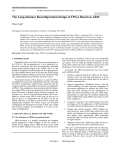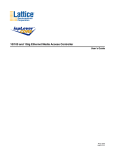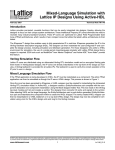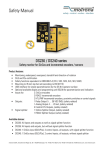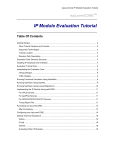Download Parallel FIR Filter IP User's Guide
Transcript
ispLever CORE TM Parallel FIR Filter User’s Guide October 2005 ipug06_02.0 Lattice Semiconductor Parallel FIR Filter User’s Guide Introduction This document serves as a guide containing technical information about the Lattice Parallel FIR Filter core. Overview The Parallel FIR Filter core is one of two FIR cores supported by Lattice. This core is designed to perform filtering with zero latency and is well suited for real-time applications. This Parallel FIR Filter core comes with the following documentation and files: • Data sheet • Protected netlist and database • Protected RTL simulation models • Source files for instantiating the core Core Specification Features • Variable number of taps up to 64 • Data and coefficients up to 32 bits • Output size consistent with data size • Zero-latency operation • Signed or unsigned data and coefficients • Full arithmetic precision • Fixed or loadable coefficients • Decimation and interpolation • Real or complex data • Selectable rounding • Scalable outputs • Fully parallel implementation • Multi-cycle modes for area/time tradeoffs • Optimization based on symmetry of filter General Description Many digital systems use filters to remove noise, provide spectral shaping, or perform signal detection. Two types of common filters that provide these functions are finite impulse response (FIR) and infinite impulse response (IIR) filters. IIR filters are used in systems that can tolerate phase distortion. FIR filters are used in systems that require linear phase and they have an inherently stable structure. For this reason, FIR filters are designed into a large number of systems. The Parallel FIR Filter core can perform filtering with zero latency and is well suited for real-time applications. The core supports two modes of computation/filtering: single-cycle mode and multi-cycle mode. In single-cycle, the filtering is done in one clock cycle and in multi-cycle, filtering is done in multiple clock cycles. Figure 1 shows the block diagram of the Parallel FIR Filter core. 2 Lattice Semiconductor Parallel FIR Filter User’s Guide Figure 1. Parallel FIR Filter Core Functional Block Diagram coeff [0:w-1] clk Coefficient Registers Multiplier Bank loadc din [0:w-1] irdy clk (number of mutipliers, m = n/c) Data Scheduler Muxed Coeff0 Tap 0 (shift reg) Muxed Data0 Adder Tree Multiplier0 delayed din 0 Tap Array (number of taps = n) Muxed Coeff1 Tap 1 (shift reg) Muxed Data1 clk Output Control Unit dout ordy real_out Multiplier1 delayed din 1 Muxed Coeff m-1 Tap n-1 (shift reg) Muxed Data m-1 Multiplier m-1 delayed din n-1 Signal Descriptions Table 1 shows the definitions of the I/O interface ports available in this core. Table 1. Parallel FIR Filter Input and Output Signals Port Name Type Active State Signal Description Rising edge Clock. Master clock input to the Parallel FIR Filter core. clk Input din[31..3:0] Input N/A Data Input. Data to be processed. In the complex parallel I/O mode, the din bus includes both the real and imaginary parts. Output N/A Data Output. The data is the filter output. In the complex parallel I/O mode, the dout bus includes both the real and imaginary parts. reset_n Input Low Reset. This signal resets all the delayed data signals to 0. coeff[31..3:0] Input N/A Coefficient. Coefficients for the filter are loaded sequentially while asserting the loadc signal. loadc Input High Load Coefficient. This signal is asserted high to load the filter coefficients (data on the coeff bus). irdy Input High Input Ready. irdy is asserted high to indicate the availability of a valid input data in the complex-serial or multi-cycle modes. ordy Output High Output Ready. ordy is asserted high by the core to signify the availability of a valid dout in multi-cycle or decimation modes. real_out Output High Real Part Output. real_out is asserted high to indicate that the real part of the complex data is being output at dout. This signal is available only in complexserial mode. dout[131..3:0] Configuration Parameters Description The user configuration parameters such as filter type, data width, number of taps and data types, which are configurable, are described in Table 2. These parameters are configured using IPexpress™, included with Lattice's ispLEVER® design tools. 3 Lattice Semiconductor Parallel FIR Filter User’s Guide Table 2. Parallel FIR Filter Parameter Definitions Name Default Value Value Filter Type Single-cycle Single-cycle, multi-cycle, decimation or interpolation Data Width 8 bits Description Type of filter selected by the user. This determines the rest of the parameter options. Real: 4 to 32 bits Width of input data (W) in bits. The width of the coefficients is also Complex: 4 to 16 equal to this parameter. For complex data types, the data width is equal to the width of the real part and the range is from 4 to 16 bits. bits Number of taps (N) in the filter. 4 to 64 Number of Taps 16 Computational Cycles 2 2 to 32 Number of cycles (C) for multi-cycle filters. Number of cycles to perform the filtering process. The output is computed once in cycles. Decimation Ratio 2 2 to 32 For decimation filters. Decimation is downsampling of the bit stream. Interpolation Ratio 2 2 to 32 For interpolation filters. Interpolation is the reverse of decimation. Rounding Method Nearest Truncation or nearest Arithmetic Type Signed Signed or unsigned Data Type Real Types of rounding available. Specifies the type of arithmetic modules for the core. If the symmetricity of the core is even or odd, then the arithmetic type is always signed. Real or complex Specifies the data type of the inputs (din and coeff) and the output (dout) of the Parallel FIR core. When complex I/O mode is selected, the arithmetic type is always signed. Complex I/O Mode Parallel Parallel or serial In the parallel I/O mode, real and imaginary parts are applied on the data bus in the same clock cycle. In the serial mode, real data is applied in the first clock cycle, followed by the imaginary data in the next cycle. Output Width Coeffs Loadable Full precision Fixed 4 to 97 Width of output data (W) in bits. If the width is less than the maximum output width determined by the core generator, the outputs are scaled. Fixed or run-time Determines if the coefficients are run-time loadable. If the coefficients are run-time loadable, the core has two additional input loadable ports, coeff and loadc, for loading purposes. If the coefficients are fixed during core configuration, no additional input ports are used. Coefficients Format Symmetricity Hexadecimal Even Hexadecimal or The coefficient values are either in hexadecimal or decimal format. decimal None, even, or odd Specifies the impulse response of the filter. Even symmetricity applies to symmetric impulse response, while Odd symmetricity applies to anti-symmetric impulse response. Decimation and Interpolation filters do not have symmetricity (The value None should be selected). If the symmetricity of the core is even or odd, then the arithmetic type is always signed. Functional Description Tap Array The Tap Array module essentially stores delayed versions or taps of input data. The number of taps of the FIR filter and the data width are user parameters, and they are fixed at the time of core generation. The array consists of N taps each of width W, which are organized as shift registers. All the data registers are reset when the reset_n input is asserted. At every clock edge, the data values are shifted into the next sequential shift register inside the Tap Array, with the first register getting the value from the input data port din. 4 Lattice Semiconductor Parallel FIR Filter User’s Guide Coefficient Registers The Coefficient Registers module stores the FIR filter coefficients. The coefficients can either be loaded at run time or can be fixed during core generation. If the user chooses to fix the coefficients, then the coeff bus and loadc ports are not used in this module. For fixed coefficients, the values are hardcoded. If the coefficients are configured to be loaded, they are loaded into the coeff registers sequentially at every clock edge. The coeff loading starts at the first clock edge after loadc goes high and continues as long as loadc is active. Data Scheduler Data scheduling is necessary to schedule the tap and coefficient data to the multiplier bank for multi-cycle computations. This module has the necessary multiplexers to supply the tap and coefficient data to the multiplier bank in batches. For a multi-cycle implementation with C cycles, the number of multipliers, M is equal to (N/C) rounded to the next higher integer. For a fully parallel implementation (C = 1), the data scheduler reduces to a direct connection. The data scheduler is also used to multiplex data for optimizing decimation and interpolation filters. Multiplier Bank The Multiplier Bank has M number of W bit wide multipliers, where M is determined as the number of taps N divided by the number of computational cycles C rounded to the next higher integer (M = ceil (N/C)). The number of multipliers is equal to the number of taps for a fully parallel implementation. The input to the bank comes from the data scheduler and the output goes to the adder tree. The maximum delay through the multiplier bank is equal to the delay of a singe multiplier. Adder Tree and Output Control Unit The Adder Tree has parallel adders instantiated in a binary tree fashion. The Output Control Unit has the scaling and rounding logic to achieve output scalability and selectable rounding. There are also data registers to provide synchronous registered output from the filter core. For a multi-cycle or decimation filtering, an adder is present in the block, which when combined with the output registers, makes an accumulator. Core Operation There are four distinct implementations of parallel FIR filter: single-cycle, multi-cycle, decimation and interpolation. This section describes these implementation types in detail. A note on rounding and truncation is also given in this section. Complex data type is supported in all the filter implementations. For a complex data type, the complex input data can be either supplied all at once (complex-parallel) or in two stages, real data followed by imaginary data (complex-serial). The following notations are used: N W C D U M OW OFW Number of taps Width of input data and coefficients Number of cycles for a multi-cycle operation Decimation ratio Interpolation ratio Number of multipliers, determined as M = Next higher integer to (N/C) Output width Output full width Single Cycle This is the simplest of all implementations, in that it assumes availability of sufficient resources for parallel implementation. For an N-tap filter, it uses N multipliers and N - 1 adders. The output is available on every cycle. The timing diagrams for the single-cycle implementations are given in Figures 2 and 3. As seen in the timing diagram, real and imaginary parts of the input are supplied in successive clock cycles in complex serial mode. The data rate is equal to half the clock rate. The input irdy should be asserted high to coincide with every valid real data at the din port. Similarly, the core asserts the output real_out whenever the real part of the output data is placed on the output bus. 5 Lattice Semiconductor Parallel FIR Filter User’s Guide Figure 2. Timing for Single-cycle, Real or Complex-parallel Mode clk din 2 1 internal data processing dout x x 3 6 5 4 8 7 1 2 3 4 5 6 7 8 x 1 2 3 4 5 6 7 Figure 3. Timing for Single-cycle, Complex-serial Mode clk din 1r 1i 2i 2r 3r 3i 4i 4r irdy internal data processing dout x x 1 x x 2 x 1r 3 1i 2r 4 2i 3r real_out Multi-cycle In a multi-cycle implementation, each output is computed over a period of C cycles. The implementation is similar to the parallel implementation, except that fewer resources are used over multiple cycles. The number of multipliers and adders used is not more than 1/Mth of those used in fully parallel implementation. There is an additional accumulator (an adder and a register combination) to accumulate the final sum through the C cycles. The timing diagrams for multi-cycle implementations are given in Figures 4 and 5. Real and Complex-parallel Modes The signal irdy is asserted during the first cycle of a multi-cycle operation, in the real and complex-parallel modes. The data output of the core changes every C cycles and remains unchanged during the data cycle (each data cycle is C clock cycles wide).The output ordy goes high during the first clock cycle of each data cycle. This operation is shown in Figure 4. 6 Lattice Semiconductor Parallel FIR Filter User’s Guide Figure 4. Timing for Multi-cycle (3 Cycles), Real or Complex-parallel Mode clk din 1 2 irdy internal data processing dout x 1 2 x 1 3 2 ordy Complex-serial Mode The data and handshake signals for a typical complex-serial mode configuration (C = 3) are shown in Figure 5. Every input data cycle has a real data cycle followed by an imaginary data cycle. Each of these real and imaginary data cycles is C clock cycles wide. The irdy input signal must be asserted high during the first cycle of every input data cycle. The output data cycles also contain a real data cycle followed by an imaginary data cycle. The ordy output signal goes high during the first clock cycle of every output real or imaginary data cycle. The real_out output signal goes high during the first clock cycle of every output real data cycle. Figure 5. Timing for Multi-cycle (3 Cycles), Complex-serial Mode clk din 1r 2r 1i 2i 3r irdy internal data processing dout x x 1 x 2 x ordy real_out 7 1r 1i Lattice Semiconductor Parallel FIR Filter User’s Guide Decimation Decimation is downsampling of the data stream. In a simple decimation filter with decimation ratio ‘D’, every Dth sample of the input is sent to the output. The danger with downsampling is that aliasing can occur if the input signal is not band-limited to 1/D of the original bandwidth. Therefore, to prevent aliasing, it is necessary to do a lowpass filtering before downsampling. The decimation filter implementation is, therefore, a cascade of a lowpass filter and a downsampler. The implementation of this is similar to a normal FIR, except that D - 1 samples are skipped at the output, after every valid output. The output data rate is 1/Dth of the input rate. The arithmetic resources are reused in this design, as it is not necessary to compute an output for every input sample. The output signal, ordy, goes high during the first cycle of each data output. For, complex-serial mode, there is an additional output, real_out, which goes high during the first cycle of every real part of the complex data. The timing diagrams for two decimation filter implementations are shown in Figures 6 and 7. Figure 6. Timing for Real or Complex-parallel, Decimation Mode (Ratio = 3) clk din 1 2 internal data processing dout x 4 3 6 5 1 4 x 1 7 4 ordy Figure 7. Timing for Complex-serial, Decimation Mode (Ratio = 3) clk din 1r 1i 2i 2r 3r 4r 3i 4i 5i 5r 6r 7r 6i 7i irdy internal data processing dout x x 1 x 4 x 1r 7 1i 4r ordy real_out Interpolation Interpolation is the reverse process of decimation. In this mode, the data is upsampled. For an interpolation ratio U, U - 1 ‘zeros’ are introduced between any two consecutive samples and the resulting expanded stream is passed through a lowpass filter. The operational environment of an interpolation filter is similar to a regular FIR filter, except 8 Lattice Semiconductor Parallel FIR Filter User’s Guide the input data rate is reduced by ‘U’ and 0’s are introduced in the taps. The timing diagrams for two Interpolation Filter implementations are shown in Figures 8 and 9. Figure 8. Timing for Real or Complex-parallel, Interpolation Mode (Ratio = 3) clk din 1 internal data processing dout x 2 3 x 1a 1b 1c 2a 2b 2c x x 1a 1b 1c 2a 2b 3a 2c Figure 9. Timing for Complex-serial, Interpolation Mode (Ratio = 3) clk din 1r 2r 1i 2i 3r irdy internal data dout x x x 1b 1a processing x x x 1ar 2a 1c 1ai 1br 1bi 1cr 2b 1ci 2ar 2ai real_out Output Scaling and Rounding When the user defined output width (OW) of the filter is less than the full output width of the filter (OFW), the outputs are scaled using a rounding scheme that is based on the parameter “rounding method”. If the rounding method is defined as “truncation”, the least significant OFW-OW bits are simply discarded and the most significant OW bits are retained in the output. If the rounding method is selected to be “nearest”, the most significant OW bits are retained and they are rounded based on the value of the least significant bits that are discarded. Truncation takes the value to the next step towards minus infinity and rounding nearest takes the value to the nearest step in either direction. Table 3 illustrates the output scaling and rounding for two numbers using integer, fixed point, signed and unsigned representations. In the example, the full output width (OFW) is 8 and the desired output width (OW) is 6. Output scaling in this case is equivalent to a division by 4. 9 Lattice Semiconductor Parallel FIR Filter User’s Guide Table 3. Example Description of Output Scaling and Rounding Binary 1010 1001 1010 1011 Mode Decimal Full Precision Divide by 4 Truncation Nearest Unsigned, integer 169 42.25 42 42 Signed, Integer -87 -21.75 -22 -22 Unsigned, FP between bit 3 and bit 4 10.5625 2.640625 2.625 2.625 Signed, FP between bit 3 and bit 4 -5.4375 -1.359375 -1.375 -1.375 Unsigned, integer 171 42.75 42 43 Signed, Integer -85 -21.25 -22 -21 Unsigned, FP between bit 3 and bit 4 10.6875 2.671875 2.625 2.6875 Signed, FP between bit 3 and bit 4 -5.3125 -1.328125 -1.375 -1.3125 IPexpress The Lattice IP configuration tool, IPexpress, is incorporated in the ispLEVER software. IPexpress includes a GUI for entering the required parameters to configure the core. For more information on using IPexpress and the ispLEVER design software, refer to the software help and tutorials included with ispLEVER. For more information on ispLEVER, see the Lattice web site at: www.latticesemi.com/software. Available Configuration(s) for Evaluation Table 4 lists the available configuration with the corresponding parameters. To obtain the evaluation version of this core, visit the Lattice web site at www.latticesemi.com. Table 4. Available Core Configuration Input Data Width Parameter File Name fir_para_xp_1_002.lpc 8 bits No. of Taps FIR Type 16 Single cycle Symmetry Arithmetic Type Data Type Output Data Width (Full data width) Symmetric Signed Real Full (21) 10 Fixed Coefficients 60, 44, D9, 37, 35, 16, F6, 39 (HEX) Lattice Semiconductor Parallel FIR Filter User’s Guide Figure 10. Dialog Box for Configuring the Parallel FIR Filter Core Figure 11. Dialog Box for Specifying the Coefficients 11 Lattice Semiconductor Parallel FIR Filter User’s Guide References and Related Information The following document will provide further information on implementing this core: • ispLEVER Software User Manual In addition to this Parallel FIR Filter core, Lattice also offers the Serial FIR Filter for similar applications. For more information, refer to the following document: • Serial FIR Filter Core User’s Guide Technical Support Assistance Hotline: 1-800-LATTICE (North America) +1-503-268-8001 (Outside North America) e-mail: [email protected] Internet: www.latticesemi.com 12 Lattice Semiconductor Parallel FIR Filter User’s Guide Appendix for ispXPGA® FPGAs Table 5. Performance and Resource Utilization1 Parameter File Parameters LUT4s2 ispXPGA PFUs3 Registers External Pins System EBRs fMAX1 (MHz) fir_para_xp_1_002.lpc See Table 6 858 297 149 31 None 51 1. Performance and utilization characteristics are generated using LFX1200B-04FE680C in Lattice’s ispLEVER 3.x software. The evaluation version of this IP core only works on this specific device density, package, and speed grade. 2. Look-Up Table (LUT) is the standard logic block of the ispXPGA. LUT4 is a 4-input LUT. 3. Programmable Function Unit (PFU) contains LUTs and other resources. Supplied Netlist Configurations The Ordering Part Number (OPN) is FIR-PARA-XP-N1. Table 6 lists the Lattice-specific netlist that are available in the Evaluation Package, which can be downloaded from the Lattice web site at www.latticesemi.com. Table 6. Description of Netlist Configuration Input Data Width Parameter File Name fir_para_xp_1_002.lpc 8 bits No. of Taps FIR Type 16 Single cycle Symmetry Arithmetic Type Data Type Output Data Width (Full data width) Symmetric Signed Real Full (21) 13 Fixed Coefficients 60, 44, D9, 37, 35, 16, F6, 39 (HEX)













